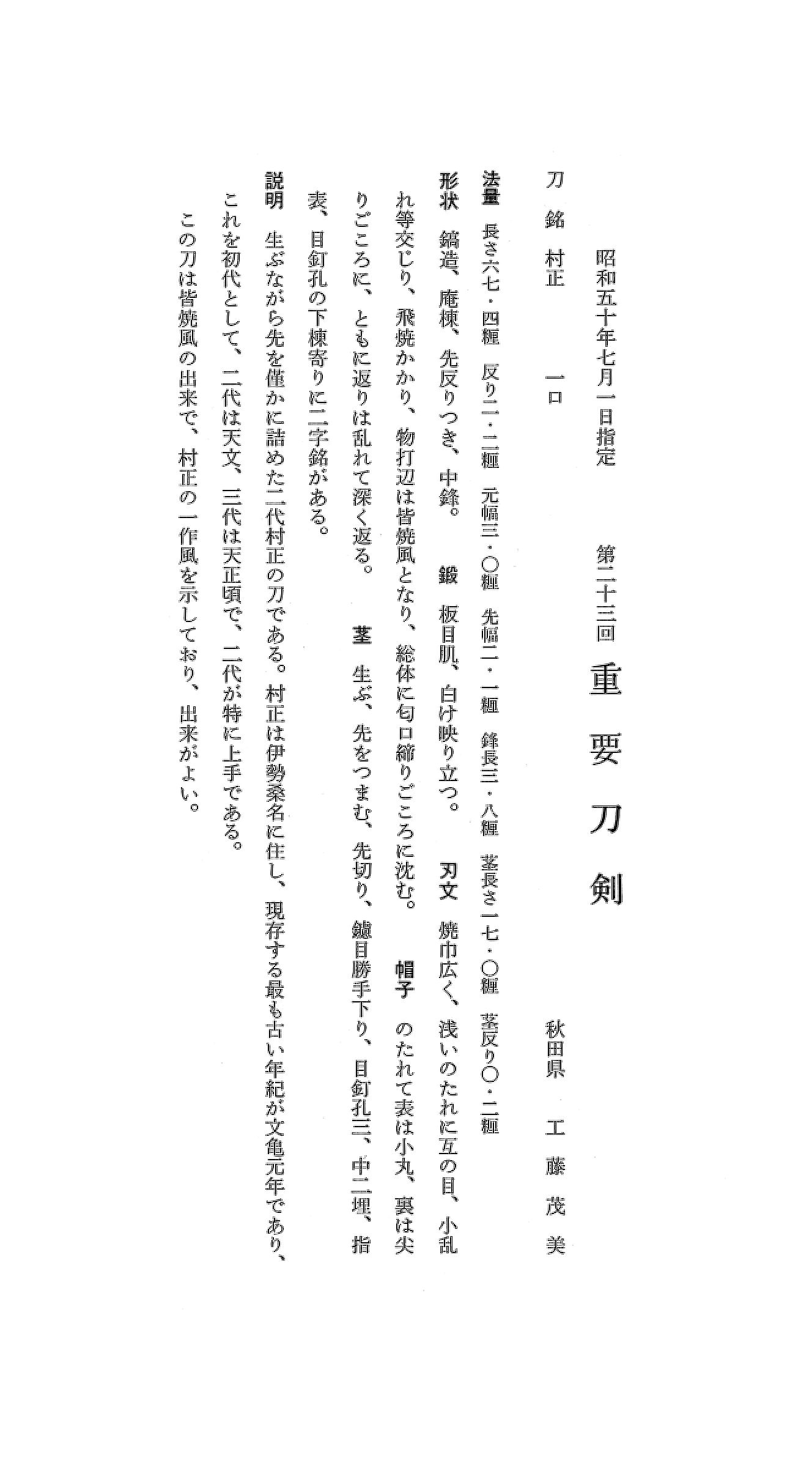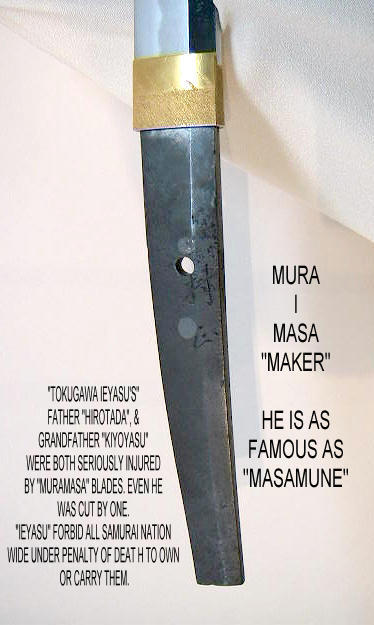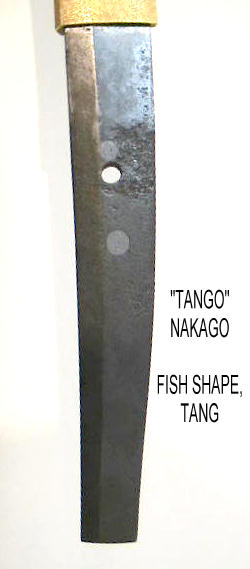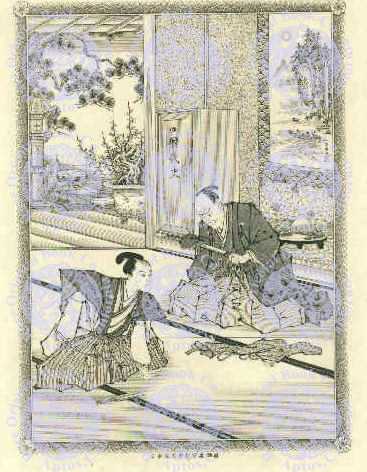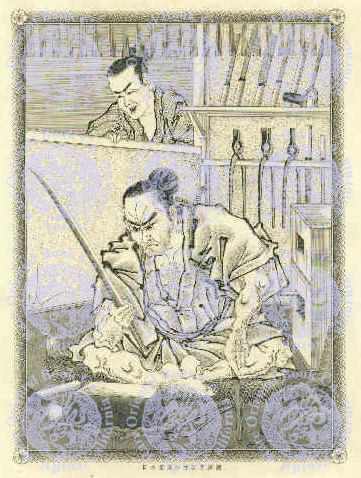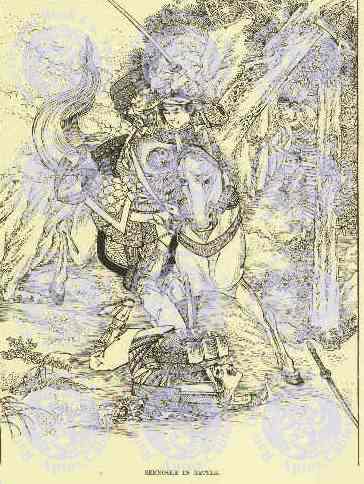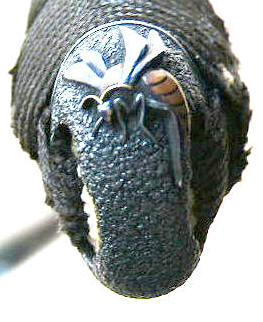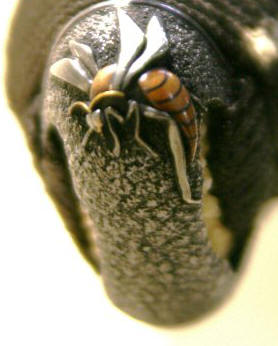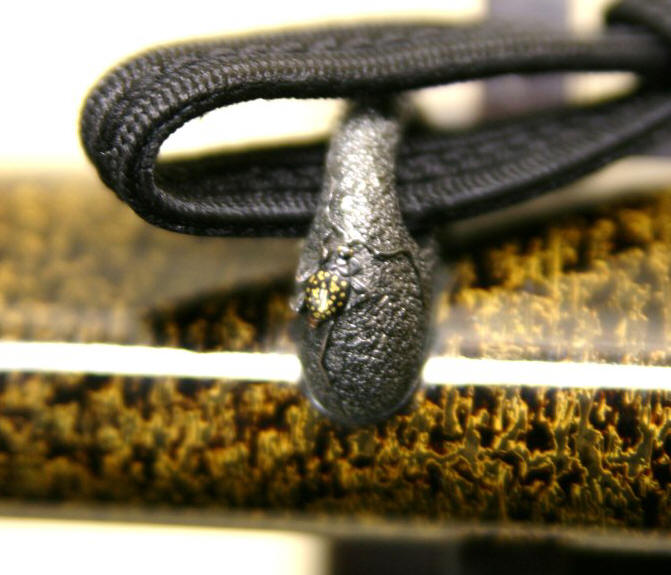Gallery Page (Display Only)
SIGNED; MURAMASA
Nidai / 2nd Gen., ISE province
Ten-Mon period, Circa 1532, Very rare!
Dealt with “Oni” (Devil) to make supreme blades
His blades are cursed against the Tokugawa family
Juyo token by the NBTHK
“MURAMASA” LIVED DURING THE BUN-GI (1501 AD.) ERA, IN “ISE” PROVINCE. THE SUPERSTITION SURROUNDING HIS BLADES, FIRST EMERGED IN 1603, WHEN “TOKUGAWA IEYASU” WAS EMPOWERED AS THE FIRST “SHOGUN” OF JAPAN! IEYASU, HARBORED STRONG, AND JUSTIFIED SUPERSTITIONS REGARDING “MURAMASA” BLADES. THESE WERE A DIRECT RESULT OF NUMEROUS TRAUMATIC AND VIOLENT INCIDENTS THAT TOOK PLACE IN HIS LIFE. BOTH HIS FATHER AND HIS GRANDFATHER WERE SERIOUSLY INJURED BY “MURAMASA” BLADES, AS WERE NUMEROUS OTHER FRIENDS AND RELATIVES, SOME OF WHOM WERE KILLED. THE BREAKING LEVEL OF HIS TOLERANCE WAS REACHED, WHEN HE WAS PERSONALLY, BADLY CUT BY A “MURAMASA” BLADE. THIS CONVINCED HIM THAT THE BLADES OF “MURAMASA” WERE CURSED, AGAINST THE ENTIRE “TOKUGAWA FAMILY”. IEYASU ISSUED AN EDICT FORBIDDING SAMURAI FROM CARRYING, AND OWNING MURAMASA BLADES. TO VIOLATE THIS EDICT MADE ONE ELIGIBLE FOR CAPITAL PUNISHMENT. THE NORMAL FORM OF EXECUTION WAS CRUCIFIXION.
MANY OF THE MURAMASA BLADES WERE “O-SURIAGED”, (THE ORIGINAL NAKAGO / TANG WAS CUT OFF) THEREBY REMOVING THE SIGNATURE. OTHERS HAD THE SIGNATURE FILED OFF, AND THE NAME OF ANOTHER SWORD MAKER INSCRIBED IN ITS PLACE. IT IS SAID THAT THE “SHOGUN IEMITSU” (THE GRANDSON OF IEYASU) ORDERED THAT MURAMASA BLADES BE DESTROYED. THIS RESULTED IN SIGNED EXAMPLES BECOMING NEARLY EXTINCT. NO ONE WOULD DARE TO OPPOSE “IEMITSU”, AS HE (UNLIKE HIS GRANDFATHER) RULED JAPAN WITH AN “IRON HAND”, AND TRUSTED NO ONE. THESE EDICTS, WERE ENFORCED THROUGHOUT THE NEARLY 300 YEAR RULING PERIOD OF THE TOKUGAWA FAMILY.
MURAMASA, AND HIS BLADES BECAME THE SOURCE OF MANY LEGENDS, SUPERSTITIONS, NOVELS AND THEATER PLAYS. IT IS BELIEVED BY MANY, MURAMASA WHILE BRILLIANT WAS ALSO QUITE INSANE, AND THAT HE “MADE A DEAL” WITH “ONI” (THE DEVIL), IN EXCHANGE FOR THE ABILITY TO PRODUCE THE FINEST QUALITY, BLADES OF SUPREME SHARPNESS. THERE IS A STORY ABOUT A DAIMYO, THAT PERFORMED A CUTTING TEST, BY PLACING A “MASAMUNE”, AND A “MURAMASA” IN A RAPIDLY FLOWING STEAM, SIDE BY SIDE, HE THEN FLOATED LEAFS TOWARD THE STANDING BLADES. NONE OF THE LEAFS WERE CUT BY THE “MASAMUNE”, WHILE THE “MURAMASA” CUT ALL OF THEM THAT STRUCK IT. THE SEVERED LEAFS THEN BEGAN TO DANCE AROUND THE BLADE IN A WHIRLPOOL PATTERN, AS IF TO TESTIFY TO ITS DEMONIC AURA. IT IS ALSO SAID, THAT NO SAMURAI COULD DRAW A MURAMASA BLADE, AND REPLACE IT IN ITS SAYA (SCABBARD), WITHOUT IT FIRST DRAWING BLOOD. THE ADVISORIES OF THE TOKUGAWA FAMILY, WOULD SACRIFICE ALMOST ANYTHING TO GAIN POSSESSION OF A TRUE MURAMASA BLADE. A SIGNED, AND VERIFIED MURAMASA, IT PERHAPS THE RAREST BLADE A COLLECTOR, COULD HOPE TO ADD TO HIS COLLECTION.
Translation:
jûyô No 4906
Certificate
katana, mei: Muramasa (??)
nagasa 67.4 cm, sori 2.2 cm
shinogi-zukuri, iori-mune, chû-kissaki; the kitae is an itame and the hamon a hardly undulating notare that is mixed with gunome, ko-midare, and other elements and that appears as hitatsura along the monouchi; the bôshi is notare with a ko-maru-kaeri on the omote, and a rather pointed kaeri on the ura side; the tang is ubu, just the tip was cut off a little, shows katte-sagari yasurime, and has three mekugi- ana of which two are plugged
According to the result of the shinsa committee of our society we judged this work as authentic and rate it as jûyô-tôken.
July 1st 1975
[Foundation] Nihon Bijutsu Tôken Hozon Kyôkai, NBTHK
[President] Honma Junji (????)
NBTHK Juyo Zufu (1975)
Juyo Translation (Certificate & Zufu):
Designated as jûyô-tôken at the 23rd jûyô-shinsa held on July 1st 1975
katana, mei: Muramasa (??)
Akita Prefecture, Kudô Shigeyoshi (????)
Measurements
nagasa 67.4 cm, sori 2.2 cm, motohaba 3.0 cm, sakihaba 2.1 cm, kissaki-nagasa 3.8 cm, nakago-nagasa 17.0 cm, nakago-sori 0.2 cm
Description
Shape: shinogi-zukuri, iori-mune, sakizori, chû-kissaki
Kitae: itame-hada with shirake-utsuri
Hamon: widely hardened but hardly undulating notare that is mixed with gunome, ko-midare, and tobiyaki and that tends to hitatsura along the monouchi, the nioiguchi is overall rather tight and subdued bôshi: notare with on the omote side a ko-maru, and on the ura sude a rather pointed kaeri, the kaeri itself runs back wide and with midare on both sides
B?shi: notare-komi with a brief kaeri that tends to yakitsume
Nakago: ubu, just the tip was cut off a little, kirijiri, katte-sagari yasurime, three mekugi-ana (two plugged), the sashi-omote side bears below of the mekugi-ana and towards the back of the tang a niji- mei
Explanation
This is an ubu-katana by the 2nd generation Muramasa of which just a little bit of the tip of the tang was cut off. Muramasa lived in Kuwana (??) in Ise province, and the oldest extant dated blade is from Bunki one (??, 1501), which is a work of the 1st generation. The 2nd generation was active around Tenbun (??, 1532-1555) and the 3rd generation around Tenshô (??, 1573-1592) and it was the 2nd generation who was most skillful.
This katana shows a hitatsura-like deki and thus demonstrates one of various known workmanships of Muramasa. It is of excellent quality.
“A Muramasa Blade” By Louis Wertheimber. (Circa 1887).
Koshirae- NTHK-NPO Certificate & translation
kantei-sho (???) – Certificate
katana-koshirae (??)
toppei-koshirae with en suite fittings and cherry tree bark-style lacquer saya
(??????????)
shôshin (??) – Authentic
Heisei 28 nen 2 gatsu 26 nichi (????????????) – February 26th 2016
Non Profit Organization (?????????)
Nihon Tôken Hozon Kai (???????) – NTHK
Board Chairman (???): Miyano Teiji (????)
No T. 1600149
meibun (??) – Signature: mumei
tsukurikomi (????) – Shape:
shitaji (??) – Foundation:
zugara (??) – Motif/Design:
hori (??) – Carvings/Engravings:
sunpô (??) – Measurements: overall length 96.5 cm
koshirae (??) – Mounting: tsuka with white same and black hishimaki wrapping;
fuchigashira, kurigata, and kojiri en suite; menuki of shakudô,
in katachibori and iroe, depicting insects; tsuba of iron, in
mokkô-gata, with a shakudô-fukurin, and ko-sukashi, mei
“Yamakichibei” (???)
bikô (??) – Remarks: recent/modern product
shinsa’in natsu’in (?????) – Seals of Judges: 5 seals
A Owari province, Nidai (2nd generation) Yamakichibei tsuba circa early Edo period
TSUBA – NTHK-NPO Certificate & translation
kantei-sho (???) – Certificate
tsuba (?)
Owari, Nidai Yamakichibei (????????) – 2nd generation Yamakichibei
shôshin (??) – Authentic
Heisei 28 nen 2 gatsu 26 nichi (????????????) – February 26th 2016
Non Profit Organization (?????????)
Nihon Tôken Hozon Kai (???????) – NTHK
Board Chairman (???): Miyano Teiji (????)
No T. 1600148
meibun (??) – Signature: Yamakichibei (???)
tsukurikomi (????) – Shape: mokkô-gata
shitaji (??) – Foundation: iron, polished finish, shakudô-fukurini
zugara (??) – Motif/Design: gourds and dumplings motif
hori (??) – Carvings/Engravings: sukashi with the inome plugged with gold
sunpô (??) – Measurements: height 7.9 cm, width 7.4 cm
koshirae (??) – Mounting:
bikô (??) – Remarks: early Edo period
shinsa’in natsu’in (?????) – Seals of Judges: 5 seals
“Masterpiece”, in the Art of lacquer work
?? Muramasa Katana
ERA:Ten-Mon 1532
APPROXIMATE AGE OF BLADE:500 Years
THE NAKAGO (TANG):Ubu
MEI (MAKERS SIGNATURE):Muramasa This is on the Omote (side worn away from the body)
JIRI (TANG END):Saki-kuri (straight cut)
MEKUGI ANA (HOLE IN TANG FOR RETAINING PEG):3, with 2 filled
Mekugi-ana from other mountings
—————————————————————-
BLADE TYPE:Katana
STYLE:Shinogi-Zukuri (most popular style)
MUNE (BACK RIDGE):Iori (peaked)
NAGASA (LENGTH OF CUTTING EDGE):67.4 cm / 26 ½”
SORI (CURVATURE):2.2 cm / 7/8”
Motohaba (WIDTH):3.0 cm / 1 ¼”
BOSHI: (TEMPERING IN POINT):Ko-maru w/ deep turn back
KISSAKI (POINT STYLE):Ikubi (medium point)
HAMON :(TEMPERING, MARTENSITE):Notare/Gomone mix, Tobiyaki with Hitsasura in the Monouchi
HADA (BLADE GRAIN STYLE):Itame w/ Shirake-Utsuri (scattered Utsuri)
KOSHRAE (FITTINGS):Fine Daimyo class with solid silver, insect theme Kodogu, Iron Tsuba, and High quality lacquer saya
——————————————————————
CONDITION:Pristine
KIZU (FLAWS):None
POLISH:100%
DAMAGE:None
HABAKI:One piece gold
SHIRA SAYA (STORAGE CASE)
This Sword is not available for purchase.
If you wish to purchase a Japanese Sword, please view our Nihonto for sale page or contact us directly via email or by telephone at 1(608) 315-0083 any time. Please include specifics of what you seek, i.e.: Katana, maker, era, price range, etc.
Pictures and content may not be copied without the express permission of samuraisword.com ©







